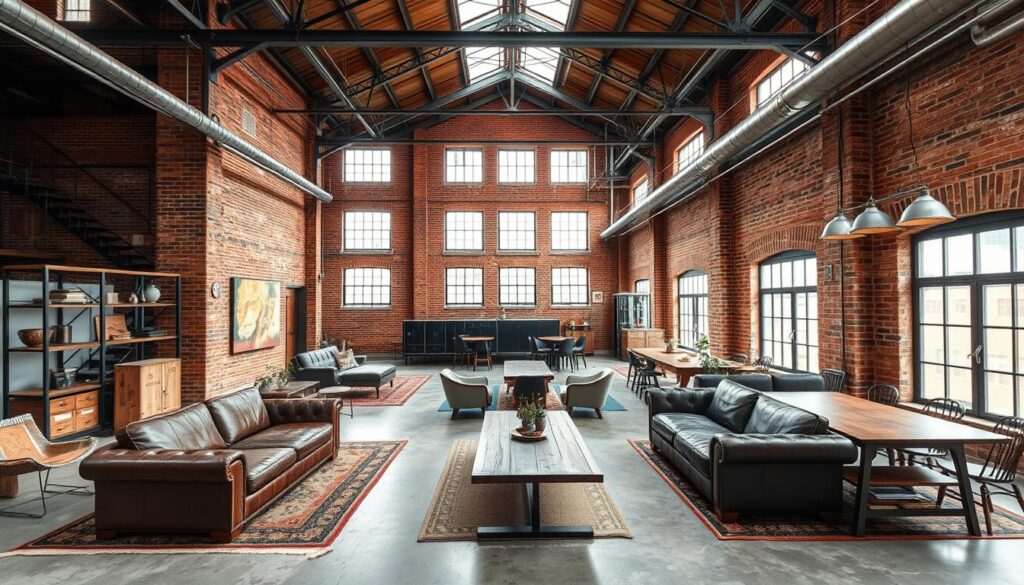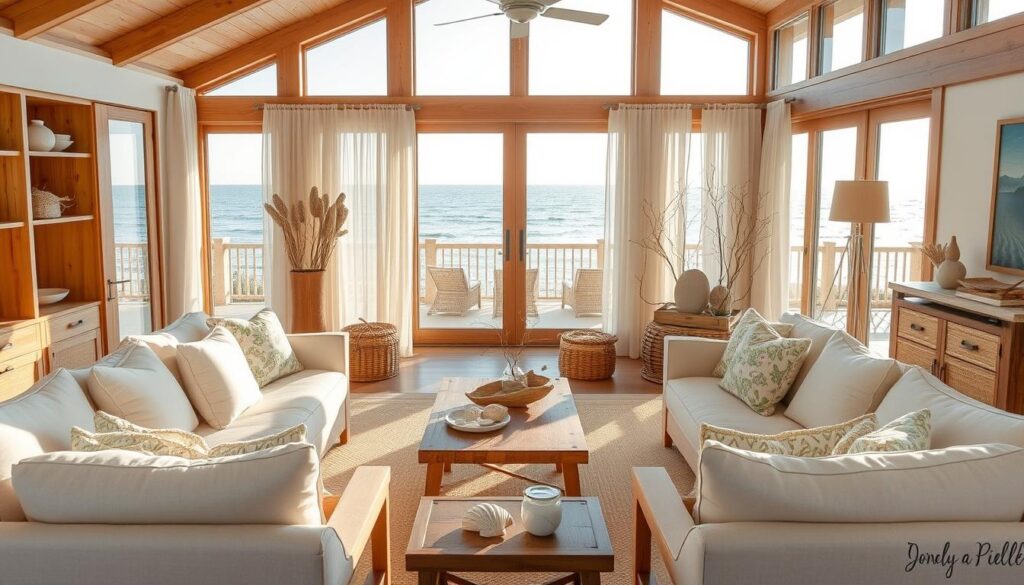Did you know that how we design our homes can really affect our mood and how well we work? With so many design choices out there, picking the perfect modern interior design can feel like a big task.
Knowing the differences between popular design styles is key to creating a space that truly shows who we are. We’ll look into how different styles can help make a room that’s both useful and beautiful.
Key Takeaways
- Understanding different interior design styles is crucial for creating a personalized space.
- Modern interior design focuses on simplicity and functionality.
- Knowing the characteristics of various styles helps in making informed decorating decisions.
- A well-designed space can enhance mood and productivity.
- Personalizing your space with the right style can make it feel more welcoming.
Understanding Interior Home Styles
Our homes show who we are. Picking the right interior style is key to making a space that feels like home. With design always changing, knowing the different styles is crucial.
What Is an Interior Home Style?
An interior style is about the look and feel of a home. It includes furniture, decor, lighting, and more. Styles range from traditional decor to contemporary home trends, each with its own charm.
Popular styles include modern, traditional, rustic, and industrial. Modern is all about simplicity, while traditional loves classic furniture and fancy details.
Importance of Choosing the Right Style
Picking the right style is key for a harmonious home. It shows our taste and affects how our home feels. The right style makes our home welcoming and relaxing.
“The right interior design style can transform a house into a home, making it a place where memories are created and cherished.”
To see how styles differ, let’s look at a table:
| Style | Characteristics | Key Elements |
|---|---|---|
| Modern | Minimalist, sleek, contemporary | Clean lines, monochromatic color scheme, minimalist decor |
| Traditional | Classic, ornate, timeless | Classic furniture, rich colors, ornate details |
| Rustic | Natural, earthy, cozy | Natural materials, earthy colors, vintage decor |
Knowing the different styles helps us design our homes better. Whether we like traditional elegance or modern simplicity, the right style makes our home reflect us and meet our needs.
Popular Interior Home Styles in the U.S.
The U.S. is filled with many interior design styles, each with its own charm. We see that some styles are more popular than others. They have a lasting appeal that many people love.
Let’s look at some of the most loved interior home styles in the U.S. We’ll explore what makes them special.
Modern Style
Modern interior design focuses on clean lines and minimal decoration. It started in the early 20th century. Now, it uses many materials and technologies, making it great for today’s homes.
Modern style loves open spaces and lots of natural light. It uses big windows and simple window treatments. The colors are mostly neutral, like whites, blacks, and grays.
Traditional Style
Traditional interior design is all about classic looks and rich history. It’s warm, comfortable, and full of details. Traditional homes have rich wood, intricate patterns, and old pieces.
Traditional style is known for its focus on details. From wooden furniture to fancy textiles, every piece is chosen carefully. This creates a welcoming space.
Rustic Style
Rustic chic is growing in popularity. People want to bring the countryside’s warmth into their homes. Rustic design uses natural materials like wood and stone. It often has exposed beams and old fixtures.
Rustic style aims to be cozy and inviting. It uses earthy colors and soft textures. This makes rustic homes feel like a peaceful retreat.
Industrial Style
Industrial loft design comes from turning old factories into homes. It features exposed brick, metal beams, and concrete floors. This style celebrates the beauty of city landscapes.
Industrial interiors have open layouts and high ceilings. They focus on functional parts like ductwork and pipes. This style is great for those who love the look of city decay.
| Style | Key Features | Color Palette |
|---|---|---|
| Modern | Clean lines, minimal ornamentation, open spaces | Neutral (whites, blacks, grays) |
| Traditional | Classic aesthetics, ornate details, rich wood tones | Warm and rich (wood tones, deep colors) |
| Rustic | Natural materials, earthy tones, cozy atmosphere | Earthy (browns, greens, tans) |
| Industrial | Exposed brick, metal beams, concrete floors, open layouts | Urban and raw (exposed materials, neutral tones) |
Each style brings something special to interior design. Whether you like modern’s simplicity, traditional’s warmth, rustic’s coziness, or industrial’s raw look, there’s a style for you.
Elements of Modern Interior Design
Modern interior design is all about mixing beauty and usefulness. It often leans towards minimalism but shouldn’t feel empty. The goal is to use materials that are subtle, not dull.
Minimalism
Minimalism is a big part of modern design. It means removing what’s not needed and focusing on what’s essential. This approach doesn’t make a space feel empty or cold. Instead, it brings calm and peace.
To get minimalism right in your home, try these tips:
- Stick to a few colors to keep things cohesive.
- Choose furniture with simple designs and little decoration.
- Use storage to keep things tidy.
Color Palettes
Choosing colors is key in modern design. Spaces often use neutral colors with bold touches to add excitement.
Here’s what a modern color scheme might look like:
| Color | Usage |
|---|---|
| White | Walls, trim |
| Gray | Furniture, accents |
| Bold Color | Accent pieces, artwork |
Furniture Choices
Furniture in modern design is simple, functional, and stylish. Look for pieces that do more than one thing.
Some top picks for modern furniture include:
- Sleek sofas with hidden storage.
- Simple coffee tables made from industrial materials.
- Comfortable, stylish office chairs.
In short, modern design aims to make spaces both beautiful and useful. By embracing minimalism, picking the right colors, and choosing practical furniture, you can create a modern home that’s inviting and peaceful.
Embracing the Traditional Aesthetic
Embracing traditional decor brings history and warmth to your home. It draws from 18th and 19th-century European styles. These styles aim for harmony and elegance.
Classic furniture, rich colors, and intricate textures are key. They make a space sophisticated and welcoming.
Classic Furniture
Classic furniture is essential in traditional design. It’s ornate, with detailed carvings and rich upholstery. Historical styles inspire our choices, like rolled arms and tufted backs.
A vintage armchair can be a room’s centerpiece. It adds both comfort and style. Designers say the right furniture makes a house feel like home. Exploring different styles helps find the perfect fit for your decor.
Color and Texture Combinations
The color palette in traditional design is rich and muted. It includes deep reds, greens, and golds. These are balanced with creamy whites and soft neutrals.
Texture is also crucial. A mix of smooth surfaces and intricate patterns adds depth. Designer
“The key to a beautiful traditional space is layering different textures and colors to create depth and visual interest.”
This approach makes the space warm and visually appealing.
To get a traditional look, mix textures and colors. For example, a velvet sofa with a wooden table and a patterned rug is cozy. Adding vintage or antique pieces brings character and history.
Exploring Rustic Charm
Embracing rustic chic means using natural materials and earthy tones in your home. This style creates a warm, inviting space that feels close to nature.
Rustic design focuses on organic elements like unpolished stone and natural wood. These add texture and depth, making a room feel cozy and comfortable.
Natural Materials
The core of rustic design is natural materials. Think wooden beams, stone fireplaces, and furniture from reclaimed wood. The goal is to show off these materials’ natural beauty, often in their raw form.
Some key natural materials include:
- Reclaimed wood for furniture and flooring
- Stone for fireplaces and wall cladding
- Natural fibers like wool and cotton for upholstery
Earthy Color Schemes
Rustic design often uses muted, earthy colors. Shades like green, brown, beige, and taupe are common. They create a soothing, calming space.
To boost the rustic feel, try these:
- Paint colors that mimic natural hues
- Furniture and decor from natural materials
- Textiles with natural patterns and textures
By mixing natural materials with earthy colors, you can make a rustic space that’s both genuine and welcoming.
Industrial Style: A Raw Appeal
Industrial interior design celebrates the raw, unfinished look of old buildings. It uses concrete walls, steel details, and simple windows in homes. This mix creates a unique blend of toughness and elegance.
Open Spaces and Layout
Industrial style is known for its open spaces and layouts. It removes walls to make rooms feel bigger and more open. This openness lets people use the space in many ways, making it versatile.

Use of Metal and Wood
Metal and wood are key in industrial design. You’ll see exposed metal beams and wood accents. These add a rugged look and warmth to the space.
Let’s explore how materials shape industrial design:
| Material | Common Uses | Aesthetic Contribution |
|---|---|---|
| Metal | Beams, ductwork, accents | Industrial, edgy |
| Wood | Furniture, flooring, walls | Warm, rustic |
| Concrete | Walls, flooring | Raw, unfinished |
By mixing these elements, we can make a space that’s both industrial and welcoming. The goal is to balance the raw, unfinished look with home comforts.
Eclectic Home Style: Mixing It Up
Eclectic style in interior design is all about mixing different things together. It creates a space that truly reflects your personality. This style is great for showing off your unique taste through your home decor.
Eclectic design is all about blending various styles. It makes your space unique and personal. You can mix furniture, colors, and textures from different styles and eras. This creates a space that is both harmonious and visually appealing.
Combining Different Styles
When you mix styles, finding a common thread is key. This thread could be a color scheme, texture, or design era. For example, you might pair a modern sofa with a vintage armchair and a traditional coffee table. The goal is to balance these contrasts so they work well together.
- Start with a neutral base: Use a neutral color on walls and floors to provide a calm background.
- Add statement pieces: Incorporate bold, eye-catching furniture or decor items that reflect your personal style.
- Mix textures: Combine different textures like smooth, rough, soft, and hard to add depth to your space.
Personal Touches in Eclectic Design
Personal touches make an eclectic space truly special. These can include family heirlooms, travel souvenirs, or personal artwork. Adding personal items not only adds character but also tells your story.
Display personal collections: Showcase your favorite items, such as vintage collectibles or artwork, on shelves or in display cases.
Use meaningful objects: Incorporate objects that hold sentimental value, like family photos or heirlooms, into your decor.
Coastal and Beach-Inspired Designs
Coastal interior design is all about openness, light, and nature’s beauty. It brings the coast’s colors and textures into your home. This creates a light and airy feel.
Coastal design loves light colors and fabrics. You’ll see lots of whites, creams, and blues. These colors remind us of the sea and sand.
Light Colors and Fabrics
To get a coastal vibe, use light, airy fabrics like cotton and linen. These fabrics make your space feel like the coast. They also add texture.
Think about using natural fibers for furniture and curtains. Sheer curtains are great for filtering light and creating a calm mood.
Incorporating Nature Indoors
Adding nature indoors is key in coastal design. Use natural materials like wood, stone, and plants. This brings the outdoors in.
| Element | Description | Example |
|---|---|---|
| Wood | Reclaimed or driftwood used for furniture or accents. | Driftwood coffee table |
| Stone | Pebbles or rocks used in decorative features. | Rock garden feature |
| Plants | Greenery that thrives in coastal conditions. | Salt-tolerant plants like succulents |
Adding these elements makes your space feel connected to nature. It captures the essence of coastal living.

Tips for Choosing Your Home Style
Finding your ideal home style means looking at your living space and what you like. The right interior home styles can change how your home feels and works.
First, understand your space’s size and layout. Measure your rooms and note where doors and windows are. Think about the natural light too. This helps you pick the right furniture and design.
Assessing Your Space
Knowing your space well is key to picking the best interior home styles. Look at your room sizes and shapes, and any special features. These can guide your design choices.
- Measure your rooms to figure out the best furniture layout.
- Remember where doors, windows, and other features are. They can affect your design.
- Think about how people move through your home and how to make it better.
Jonathan Adler said, “Design is about making a space that feels good and inspires you.” This shows how important it is to know your space for a comfy and useful home.
“The way you furnish and decorate your home shows your personality and taste.” –
Considering Your Lifestyle
Your lifestyle affects the best modern interior design for your home. Think about how you use your spaces and what you need.
If you work from home, you might need a special office. If you like to entertain, a big living area is important. By thinking about your lifestyle, you can make a home that looks good and works well.
The secret to the perfect home style is finding a balance between looks and function. By understanding your space and lifestyle, you can make a home that shows who you are and meets your needs.
Bringing It All Together
Creating a harmonious and functional living space is all about careful planning. We look at different interior home styles and how trends shape our choices.
Creating a Unified Space
To blend different design styles, focus on harmony in your home. Choose a theme or element that connects them, like a common color or texture.
Final Considerations for Your Home Style
When picking a home style, think about your lifestyle and what you like. Understand your space and the elements of various styles. This way, you can make a home that shows your taste and meets your needs.
By mixing elements from various styles and keeping up with trends, you can make a space that’s both stunning and practical.



